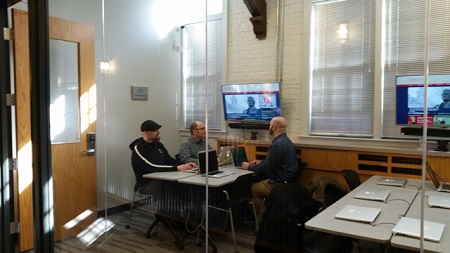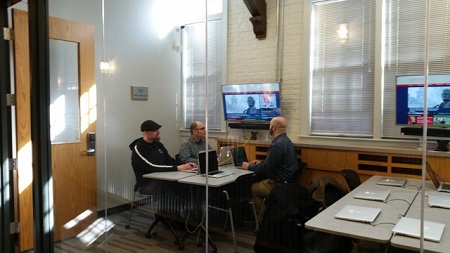In the world of educational technologies, the discussions about classroom standards and standards implementation are like an unprepared contractor—always yapping about finishing the project but tough to get nailed down. Many of these discussions are open-ended and constantly evolving, coming to under-defined conclusions. Most technology managers agree that standards for campus-wide classroom technologies are essential to efficient, economical and useful spaces. As I have previously discussed, technology standards reduce the training time for faculty, manage expectations of faculty and students, keep student experience consistent, ease budgetary strain and, perhaps most important to technology managers, reduce the cost of and time required for equipment maintenance and downtime. There is no doubt that classroom technologies are a large investment. The need to define and calculate the successful use of the space is essential. To help develop campus-wide standards for most effective and efficient technology rich learning environments, there are a number of guidelines, ratings, and association standards that can be considered.
AV solutions from FSR were included in a recent AV upgrade at historic Muhlenberg College in Pennsylvania. InfoComm Guidelines

This year, InfoComm released a “how to” document titled AV/IT Infrastructure Guidelines for Higher Education. Greg Brown, Lead Technician, UCLA, thankfully offered a “Cliff’s Notes” version in his InfoComm blog series about the subject. More specifically, he discussed the need for classroom design standards campus-wide and how to utilize these guidelines when developing standards. This document seems to offer recommendations but maintains a distance from other parallel industry standards such as USGBC’s LEED, or even the still nascent (or more appropriately, in-utero) STEP rating system. In other words, building planning, construction and infrastructure considerations are highly influential when developing classroom design standards, however, this guideline is presented as a framework about how to communicate with all stakeholders involved in classroom design and deployment strictly from a technology systems viewpoint. The communication—a system of checks and balances throughout every phase of design, installation and support—should include the requirements, expectations and standards or specifications from the school level (facility planners and school AV staff) and also cites a variety of existing InfoComm design standards where applicable. While it is a great start, it isn’t quite comprehensive.
When developing classroom technology design standards, one important consideration is often overlooked. Aside from efficiency and economy, classroom design standards should be developed first and foremost with successful learning as the priority (some schools still struggle with how to define and test for successful learning). This is rarely prioritized because technology managers, those who deal in the day-to-day of classroom technologies, often don’t have access to the metrics that support successful student outcomes. They more often have access to a faculty wish list for their classrooms. A classroom design standard for technology managers becomes about standardizing on equipment, interface and basic spacial planning to set the locations of displays/screens, equipment and storage; offering different “tiers” of standards for rooms of varying capacities. It may also include equipment lifecycle and maintenance planning and ideal upgrade/refresh scheduling.
Educause Ratings
Active learning and collaborative environments are increasingly popular due to the implications. Each campus seems to have a different definition of what an active learning classroom looks like, but many agree that flexibility and interactivity are paramount to the success of an active learning space. The Educause Learning Initiative is developing a certifiable standard called the Learning Spaces Rating System (LSRS). LSRS is based on recognized architecture and building rating systems like LEED and give points for hitting effective spacial and technological milestones. These benchmarks are pre-determined based on the effect on student learning outcomes. In fact, it goes so far as to claim that it will not only “guide the planning and design of learning spaces” but also “objectively measure a design’s strength to support active learning.” Currently in the “alpha” level of development, the LSRS specifically “define a common, updatable standard for learning spaces that can be used to guide the design of new spaces, assess the design of existing spaces, and create a platform for comparison across institutions through a third party certification.” One of the key differentiators of the LSRS is that it takes into account the need for pedagogical changes, support and faculty training in order to create a successful classroom environment. Therefore, it is not focused simply on the physical space, furniture, facility or technology. It also considers all stakeholders including architects, designers
Right now the LSRS certification relies on self-auditing for certification, possibly making it more subjective than intended. However, third-party certification could make the LSRS certification more cumbersome and costly. Yet to be seen is if there is perceived need for a certification for learning spaces when the empirical data for the effect of learning spaces on learning outcomes continues to change with technological innovation and advancing configurations.
AQAV Certification
Do following guidelines and rating systems guarantee a quality classroom technology installation? The Association for Quality in Audiovisual Technology (AQAV) says not necessarily. Many times during learning space technology design and installation the school’s team (or Buyer) are blind to the strategies and techniques used by the designers and technicians, except for approving the final product design, budgeting and perhaps making recommendations based on previous experience with product. However, if the buyer requires the design and installation team to utilize the AV9000 Standard, the standard developed by AQAV based on the international ISO 9000, “it empowers the buyer by giving the buyer a means and a language to approve or disapprove work performed. AQAV also provides a suite of education programs that provide training on how to get the most out of applying the standard.” This results in cost savings (reduction in change orders), time savings and minimal down time (reduction in warranty/support calls).
AQAV asserts that “individual skills and certifications are of course a necessity for assuring quality, but without quality management in the AV company’s internal processes, there is no assurance of consistency in what the company provides. AV 9000 Compliance goes beyond individual skills. It verifies that there is some evidence that those individual skills are being applied in a manner to assure that the buyer is getting what was ordered.” AQAV requires third party auditing, in line with the ISO 9000 standard, which assures an objective evaluation.
At some point, one asks how many guidelines, ratings and certifications does it really take to design, build and implement a successful learning space. Does it all become cumbersome, confusing, costly and convoluted? It may. Each school must first define what a successful learning space is, what learning through technology means and the appropriate team must become educated in relevant guidelines/certifications and develop appropriate campus-wide standards. A decision should be made about which to adhere to, based on the resources and requirements of the schools. Frequent evaluation of the learning space outcomes, student and faculty feedback are necessary to determine if the processes and standards are effective or if others should be considered. It is most likely a constantly evolving process.
Gina Sansivero is Director of Business Development, Education at FSR, Inc. in Woodland Park, New Jersey. FSR is a U.S. manufacturer which offers AV/IT connectivity, infrastructure, signal management and collaborative technology products worldwide. Gina is a member of InfoComm International. For more information visit www.fsrinc.com or www.fsr.education. To reach Gina directly, email gsansivero@fsrinc.com or chat on twitter @GinaSans.

